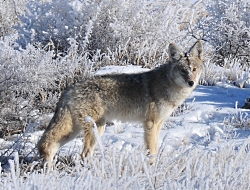
Since that long ago time, my admiration for this amazing animal has only heightened. It’s fascinating behavior, intelligence, and cultural significance are all worthy of mention.
Coyotes now occur throughout most of North America, as well as in parts of Latin America. It has been described as “the most vocal of all North American mammals”. Its penetrating range of vocalizations gave it the name Canis latrans, meaning “barking dog”. Its wild song awakens something deep within my primal being.

19th-century writers wrote of coyotes being kept in native villages in the Great Plains. Although shy, pups have been raised for hunting both as retrievers and pointers. In 1945 a tame coyote named “Butch”, had a short-lived career in cinema, appearing in Smoky and Ramrod before being shot while raiding a henhouse.
Coyotes were occasionally eaten by mountain men. It was sometimes featured in feasts of the Plains Indians, and coyote pups were eaten by the indigenous people of California. The taste of coyote meat has been likened to that of the wolf, and is more tender than pork when boiled.
At one location in Southern California, coyotes began relying on a colony of feral cats as a food source. Over time, the coyotes killed most of the cats, and then continued to eat the cat food placed by people who were maintaining the cat colony.
Fortunately, in my view, it is nearly impossible to eradicate coyotes from an area. Despite large-scale and expensive efforts to kill coyotes over the past 150 years, coyotes continue to thrive, as I was reminded on my run up SLC’s City Creek Canyon where two families on either side of the canyon serenaded on me.
Research suggests that when aggressively controlled, coyotes can increase their reproductive rate by breeding at an earlier age and having larger litters, with a higher survival rate among the young. This allows coyote populations to quickly bounce back, even when as much as 75 percent of their numbers are removed. For coexisting peacefully with this remarkable being, check out Projectcoyote.org.
Long live America’s song dog!
This is Jack Greene reading and writing for Wild About Utah.
Credits:
Images: Courtesy US FWS, Tom Koerner and Steve Thompson, Photographers
Text: Jack Greene, Bridgerland Audubon Society
Additional Reading:
Jack Greene’s Postings on Wild About Utah, https://wildaboututah.org/author/jack/
Coyote-Canis latrans, Wikipedia.org, https://en.wikipedia.org/wiki/Coyote
Coyote, Animals, Photo Ark, The National Geographic Society, https://www.nationalgeographic.com/animals/mammals/c/coyote/
Coyote-Canis latrans, DesertUSA.com and Digital West Media, Inc., https://www.desertusa.com/animals/coyote.html
Coyote, Learn, Yellowstone National Park, US National Park Service, US Department of the Interior, https://www.nps.gov/yell/learn/nature/coyote.htm
Coyote – Canis latrans, Utah Species, Utah Division of Wildlife Resources, Department of Natural Resources, State of Utah, https://fieldguide.wildlife.utah.gov/?species=canis%20latrans
